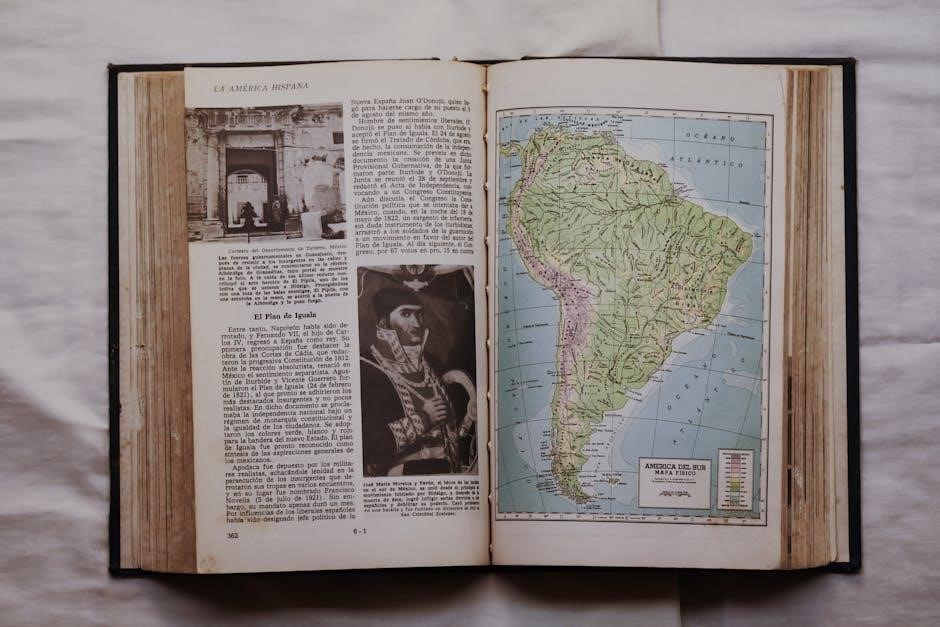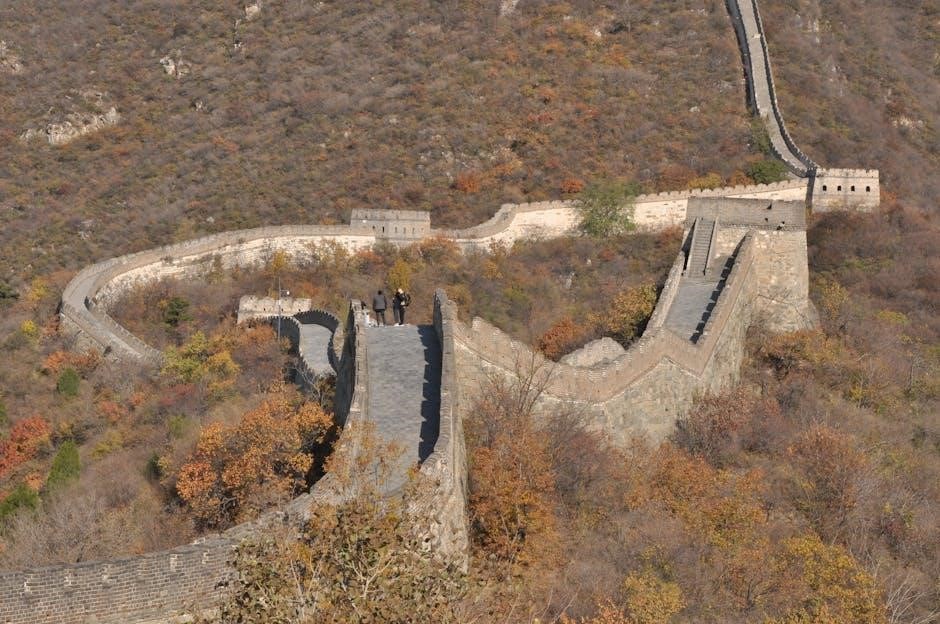world history textbook 9th grade pdf

Welcome to the 9th Grade World History Textbook, designed to explore key historical periods and themes. This comprehensive guide covers ancient civilizations, modern global events, and critical concepts like nationalism and imperialism. Structured to align with curriculum standards, it offers engaging lessons, study aids, and digital access for a deeper understanding of our shared past. Perfect for students seeking a detailed yet accessible approach to world history.
Overview of the Textbook
The 9th Grade World History Textbook is a comprehensive resource designed to cover essential historical periods and themes. It begins with ancient civilizations, tracing the development of human societies and their cultural achievements. The textbook then transitions to the medieval and early modern eras, exploring the rise of empires, religious influences, and the impact of exploration. Modern world history is also thoroughly examined, focusing on revolutions, global conflicts, and the emergence of contemporary issues. Structured into clear modules and lessons, the textbook aligns with curriculum standards to ensure a balanced and engaging learning experience. Supplementary materials, such as workbooks and study guides, are available to reinforce understanding. Digital access and PDF versions provide flexibility for students to study anywhere, making this textbook a versatile and valuable educational tool.
Importance of Studying World History

Studying world history is crucial for understanding global connections and the complexities of human societies. It fosters critical thinking by analyzing past events, ideologies, and cultural exchanges. By examining nationalism, imperialism, and revolutions, students gain insights into how historical forces shape contemporary issues. This subject encourages empathy and perspective-taking, essential for navigating an interconnected world. Additionally, it prepares students for high school and beyond by developing research and analytical skills. The 9th-grade curriculum emphasizes these aspects, ensuring students can apply historical knowledge to real-world problems. Engaging with world history empowers young minds to become informed and thoughtful global citizens, ready to contribute meaningfully to society.

Key Historical Periods Covered
The textbook explores ancient civilizations, the Scientific Revolution, and modern world history, offering insights into Roman Civilization, the Rise of Christianity, and global transformations over time.
Ancient Civilizations
The textbook delves into the origins of human society, tracing the rise of ancient civilizations in Africa, the Mediterranean, and beyond. Lessons explore early human development, cultural advancements, and the formation of complex societies. Key topics include the emergence of agriculture, the development of writing, and the contributions of civilizations such as ancient Rome and early Christian communities. Students gain insights into the social, political, and religious structures that shaped these societies. The module also examines the legacy of these civilizations, highlighting their enduring impact on modern global cultures and systems. This section provides a foundational understanding of how ancient worlds laid the groundwork for contemporary societies.
Medieval and Early Modern History
This section explores the transformative periods of the Middle Ages and the early modern era, highlighting the cultural, religious, and political developments that shaped global history. The textbook examines the rise and influence of religious movements, such as Christianity and Islam, and their impact on societies. Key events, including the Crusades, the Renaissance, and the Scientific Revolution, are discussed in detail. Students learn about the emergence of nation-states, the role of monarchies, and the beginnings of global exploration. The module also covers the social and economic changes brought by the Black Death and the Age of Exploration. By studying this period, students gain a deeper understanding of how medieval and early modern events laid the foundation for the modern world. The lessons emphasize critical thinking and historical connections, fostering a comprehensive view of these pivotal centuries.
Modern World History
This section delves into the significant events and transformations of the modern era, from the 18th century to the present. The textbook examines the Industrial Revolution, which reshaped economies and societies globally. It explores the causes and consequences of World Wars I and II, including their impact on political landscapes and global relations. The Cold War and its ideological divisions are also covered, along with the decolonization of Africa and Asia. Students learn about the rise of globalization, technological advancements, and the interconnectedness of the world. The module emphasizes the role of key figures, movements, and ideas that have shaped contemporary issues. By studying modern history, students gain insights into the complexities of global conflicts, economic systems, and cultural exchanges that define our world today. This section prepares learners to understand the roots of current events and challenges. The lessons are designed to promote analytical thinking and a deeper appreciation of how the past influences the present. The modern world history section is essential for building a well-rounded perspective on global dynamics and future possibilities.

Structure of the Textbook
The 9th-grade world history textbook is organized chronologically, with chapters divided into historical periods, thematic units, and skill-building modules. Each section includes primary sources, visuals, and assessments to enhance understanding and retention. The textbook aligns with curriculum standards, ensuring comprehensive coverage of key events, concepts, and skills. It integrates digital resources and interactive elements to cater to diverse learning styles. The clear structure promotes logical progression, helping students build a strong foundation in world history. The layout is user-friendly, with headings, subheadings, and bullet points for easy navigation. This design supports both classroom instruction and independent study, making it accessible for all learners.
Chapter Breakdown
The textbook is divided into 12 chapters, each focusing on a distinct era or theme in world history. Chapters begin with ancient civilizations, exploring early societies like Mesopotamia, Egypt, and the Indus Valley. Subsequent chapters delve into classical civilizations such as Greece and Rome, followed by the rise of major world religions. The medieval period covers feudalism, the Crusades, and the Islamic Golden Age. Early modern history includes the Renaissance, Enlightenment, and colonialism. Modern chapters address industrialization, World Wars, and global interconnectedness. Each chapter includes timelines, maps, and primary sources to enhance comprehension. Key concepts and review questions are highlighted to reinforce learning. The breakdown ensures a logical progression, making it easy for students to follow and retain information.
Lessons and Modules
The textbook is organized into interactive lessons and modules designed to engage students and deepen their understanding of world history. Each module focuses on specific themes, such as cultural exchange, political systems, and technological advancements. Lessons incorporate hands-on activities, like analyzing primary sources, creating timelines, and participating in debates. Interactive modules include digital simulations, quizzes, and collaborative projects to enhance learning. Assessments are integrated to track progress and reinforce key concepts. The modular approach allows for flexibility, enabling teachers to adapt content to meet diverse learning needs. This structured yet dynamic format ensures students develop a comprehensive understanding of historical events and their global significance.
Alignment with Curriculum Standards
The textbook is carefully designed to align with national and state curriculum standards for 9th-grade world history. It incorporates key themes and skills outlined in the Common Core State Standards and the National Council for Social Studies (NCSS) frameworks. Each chapter and module addresses specific learning objectives, ensuring students develop critical thinking, historical analysis, and research skills. The content is structured to meet the benchmarks for understanding global connections, cultural diversity, and historical causation. Assessments and activities are tailored to evaluate mastery of these standards, providing a comprehensive foundation for high school and beyond. This alignment ensures a rigorous and relevant educational experience.

Key Themes and Concepts
The textbook explores cultural exchange, empire-building, technological progress, and social change, shaping a global perspective of historical events and their modern implications.
Nationalism and Its Impact
Nationalism, a central theme in world history, emphasizes loyalty and devotion to one’s nation, often shaping cultural identity and political movements. It has driven both unity and conflict, fostering pride in national heritage while sometimes leading to exclusionary policies. The rise of nationalist ideologies in 19th-century Europe and beyond transformed borders and societies, influencing wars, revolutions, and independence movements. In the 20th century, nationalism played a key role in decolonization but also fueled tensions during the World Wars. Understanding nationalism’s dual nature—its ability to inspire progress and provoke division—is crucial for grasping global dynamics and modern political challenges, making it a vital concept in historical education.
Imperialism and Globalization
Imperialism, the domination of one country over another, shaped global power dynamics, particularly during the 19th and early 20th centuries. European empires expanded, influencing cultures, economies, and political systems worldwide. Globalization, the increasing interconnectedness of nations, emerged from trade, technology, and cultural exchanges. While imperialism often led to exploitation, globalization fostered economic growth and cultural diversity. Both concepts highlight the interconnected nature of the world, demonstrating how historical events have shaped modern societies. Understanding imperialism and globalization helps students grasp the complexities of international relations, economic systems, and cultural interactions, providing insights into the roots of contemporary global challenges and opportunities.
Revolution and Social Change

Revolutions and social movements have profoundly shaped world history, driving political, economic, and cultural transformations. The American and French Revolutions established democratic ideals, while the Industrial Revolution reshaped societies through technological and economic shifts. Social changes, such as the abolition of slavery and women’s suffrage, addressed inequality and expanded rights. These movements often arose from resistance to oppression, sparking reforms that continue to influence modern societies. Studying revolutions and social change helps students understand the complexities of human progress, the power of collective action, and the ongoing struggle for justice and equality. This section explores key events and their lasting impacts on global development.

Resources and Study Aids
The textbook offers workbooks, study guides, and digital tools to enhance learning. Additional online resources, including interactive timelines and quizzes, support student engagement and understanding of world history.
Workbook and Worksheets
The workbook and worksheets are essential companions to the 9th-grade World History textbook. Designed to reinforce learning, they include exercises, maps, and primary source analyses. Each chapter has corresponding activities that encourage critical thinking and skill development. The workbook aligns with the textbook’s curriculum, ensuring a comprehensive review of key concepts. Worksheets focus on historical events, cultural comparisons, and cause-and-effect relationships, helping students engage deeply with the material. Interactive elements, such as timelines and document-based questions, cater to diverse learning styles. These resources are available in print and digital formats, making them accessible for all learners. They provide a structured way to practice and master the content covered in the textbook.
Study Guides and Summaries
The study guides and summaries in the 9th-grade World History textbook are tailored to help students grasp key concepts efficiently. These resources provide concise overviews of each chapter, highlighting major events, themes, and figures. Summaries are organized chronologically, making it easy to track historical developments. Study guides include lists of important terms, definitions, and key dates, serving as valuable tools for review. Additionally, they offer insights into cause-and-effect relationships and the broader impact of historical events. Designed to complement the textbook, these materials enable students to focus on essential information, making them indispensable for exam preparation and deeper understanding of the subject.
Digital Access and PDF Versions
The 9th-grade World History textbook is available in a convenient PDF format, ensuring easy access for students. Digital access allows learners to study anywhere, on various devices, at any time. The PDF version is fully searchable, with interactive features like hyperlinks to additional resources and multimedia content. Students can highlight text, add notes, and bookmark important pages for quick reference. This format also supports offline learning, making it ideal for environments with limited internet connectivity. The PDF version is regularly updated to reflect the latest historical research and curriculum standards, ensuring students have the most accurate and relevant information. This digital option enhances flexibility and engagement in learning World History.

Importance of Historical Education
Studying history helps students understand the past, its impact on the present, and its role in shaping future societies. It fosters critical thinking, empathy, and cultural awareness.
Understanding Global Connections
Understanding global connections is vital for grasping how different regions and cultures have interacted throughout history. By studying world history, students learn how trade, migration, and cultural exchanges shaped societies. This knowledge helps them recognize the interdependence of nations and the shared challenges humanity faces. Historical events, such as the Silk Road or the Columbian Exchange, illustrate how global interactions have influenced economies, cultures, and political systems. This understanding fosters empathy and a broader perspective on contemporary issues, enabling students to appreciate the complexity of global relationships. It also equips them with the critical thinking skills to analyze how past interactions shape present and future connections.
Developing Critical Thinking Skills

Studying world history encourages students to develop critical thinking skills by analyzing complex events and diverse perspectives. The textbook prompts learners to evaluate evidence, question assumptions, and draw informed conclusions. Through examining historical patterns and causal relationships, students refine their ability to solve problems and think analytically. Engaging with primary sources and interpreting different viewpoints fosters deeper comprehension. These skills are essential for academic success and real-world decision-making. By applying critical thinking, students can better navigate complex issues and develop well-supported arguments. This approach prepares them to address challenges thoughtfully and effectively in their future endeavors.
Preparing for High School and Beyond
The 9th-grade world history textbook serves as a foundational tool for preparing students for high school and future academic challenges. By exploring diverse historical themes, learners develop a robust understanding of global events and their relevance to contemporary issues. The curriculum emphasizes research skills, critical thinking, and analytical writing, equipping students with essential tools for advanced coursework; Structured chapters and lessons introduce complex concepts in an accessible manner, fostering academic confidence. Additionally, the textbook’s focus on historical context and cultural awareness prepares students for interdisciplinary studies and lifelong learning. This comprehensive approach ensures learners are well-equipped to excel in high school and beyond.

Accessing the Textbook
The 9th-grade world history textbook is available as a PDF download online. Students can access digital copies through school portals or educational platforms, ensuring easy convenience.
Downloading the PDF
The 9th-grade world history textbook in PDF format is easily accessible online. Students can download it directly from official educational websites or school portals. Ensure you navigate to the correct resource section, select the appropriate edition, and click the download link. Most PDFs are free and compatible with common devices. Adobe Acrobat or similar software may be required to open the file. Once downloaded, the textbook can be saved for offline use, allowing students to study anytime, anywhere. Always verify the source to ensure it’s an official or authorized version. For assistance, contact your school or check with instructors for additional guidance. This format provides flexibility and convenience for learning.
Online Resources and Supplements
Beyond the PDF, students can access online resources and supplements to enhance their learning experience. These include interactive maps, timelines, and quizzes that complement the textbook content. Many publishers offer companion websites with additional materials, such as primary sources, video lectures, and practice exercises. These tools help students engage with the material in a more dynamic way. For example, interactive simulations can recreate historical events, while online discussion forums allow collaboration with peers. Teachers may also provide links to supplementary readings or multimedia resources. These online features are designed to deepen understanding and provide a well-rounded education. Always check the textbook’s official website or consult with instructors for access to these valuable resources. They are often free or included with the textbook purchase. Regularly exploring these supplements can significantly improve study outcomes.